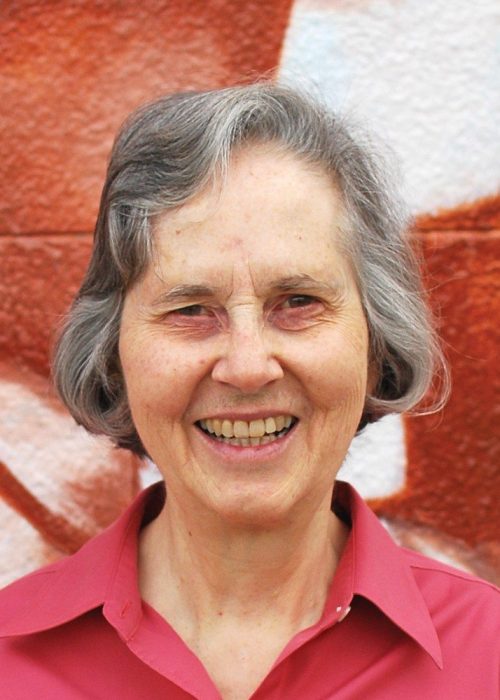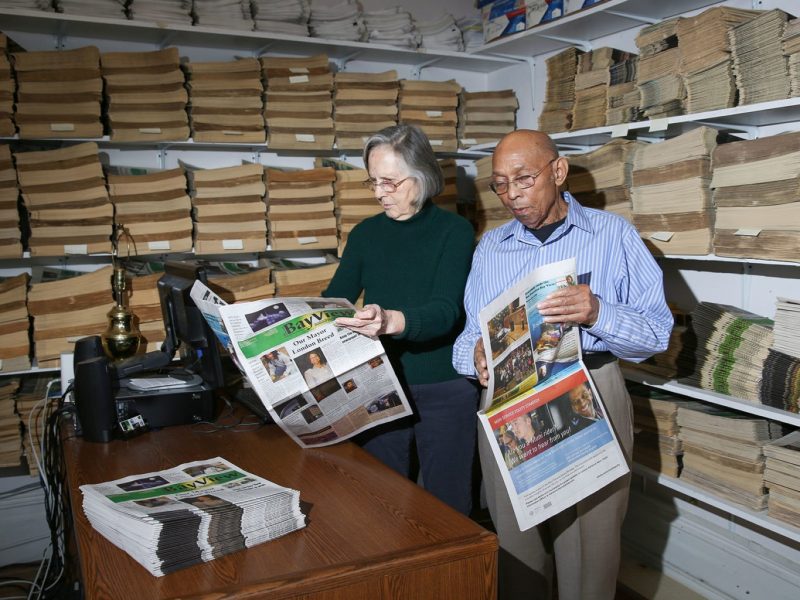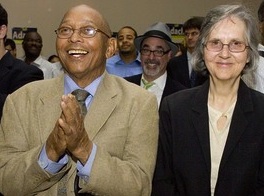Intrigued by her parents’ Communism, activist’s path led to San Francisco, where she and her husband have brought news to the Black community for nearly 30 years.
They thought she might become a professional flutist. When Mary Ratcliff was only nine, she joined the Seattle Youth Symphony Orchestra.
But by the age of 15, she realized she didn’t have the drive it took to become a professional. More importantly, what she really wanted was to “be with people who discussed the big issues. The world was in a mess and we had to fix it.”
Ratcliff was born in 1939 in New York to parents trying to fix that mess. They were communists: her mother a strike organizer and her father a writer for the Daily Worker. By her teens, the Red Scare had taken hold; the government under Republican Sen. Joseph McCarthy was on the hunt for alleged communist subversives.
Her parents never talked about it. She learned why much later – on the Internet. “I think they were afraid that if I knew anything, I, and they, might be persecuted. Everyone lived quiet lives behind white picket fences — no discussion, no debate in public,” she said. “People were so afraid they taught themselves not to say anything “dangerous” even in private.
But Ratcliff “wanted to know what communism was about, to understand philosophy.” Her search led to a life advocating for the disadvantaged.
Since 1991, she and her third husband, Willie Ratcliff, have single-handedly run the San Francisco Bay View newspaper, known under their ownership for its coverage of local news and prison issues – a topic of great concern to the Black community with its disproportionately high rate of imprisonment.
Update: San Francisco Bay View becomes a cooperative. San Francisco Public Press, Jan. 11, 2021.

You could say Mary’s own form of activism began in Alaska, where she moved after divorcing her first husband. She founded a daycare and after-school program for her own two children and others whose parents couldn’t afford the going prices. Wanting to bring affordable daycare to more parents, she successfully lobbied for adoption of the Alaska Day Care Assistance Act. Alaska was also where she met and married Willie, a major contractor and one of the leading Black political actors in the state.
First step: getting into college early
The couple’s fight for justice has been a long and sometimes difficult journey. They have struggled financially, at one point selling their home to keep the paper going. Now, her husband has a chronic illness and Ratcliff is about to start immunotherapy for breast cancer and is ready to hand over the reins.
At 16, after returning home to Seattle from a summer music camp in Aspen, Co., she informed her parents that she intended to bypass her last year of high school and enroll in Oberlin College’s early admissions program. The Ohio school was one of the few with such a program – and she wanted to be close to New York, where her parents had been activists during the Depression.
Yet when she applied, Ratcliff discovered the college planned to end the program. That didn’t stop her. She convinced her father to buy her a train ticket to Oberlin, where the president agreed to give the program another try and admit her.

Her first year there was almost perfect. Her friends were bright and curious. “We sat around at night smoking Turkish cigarettes, drinking vodka and talking big ideas.” One friend went on to become head of the World Health Organization; another a leading expert on the death penalty. Whenever she could get away from college, she’d “make a beeline for New York City to try to find out more about what her parents and all the revolutionary forces had done. I wanted to hook up with people like that, people who dared to think of the common good above their own greed.”
Feeling restricted by rules imposed on female but not male students, she did not return to Oberlin for a third year. She hoped to eventually attend Barnard, a private women’s liberal arts college in Manhattan, or Fisk, a private historically Black university in Nashville.
Idealism runs into ‘classist’ conservatism
In the meantime, back at home in Seattle, Ratcliff put her nascent idealism to work: When the U.S. began accepting refugees from Hungary’s failed 1961 revolution, she convinced her parents to take one in. One thing led to another, and she became pregnant by the young man. Her parents didn’t respond as she’d hoped. They forced her into marriage, then disowned her.
“Even though as Communists, they believed in the dignity of the worker, my mother called my husband a ‘street kid’ and considered him beneath our family,” she said. “Classism dies hard. The irony in all that has only struck me very recently.”
“I found myself pregnant and married to someone I couldn’t even talk to because he hadn’t yet learned English, nor had I learned Hungarian. But I said to myself, ‘You made your bed; now lie in it’.”
Her husband was brilliant, she said, but violent to her and their children. Spousal abuse was just beginning to be discussed during the early years of their marriage, in the mid-60s. Up until the mid-’70s, there were no shelters for abused women. At the time, even radical women couldn’t see a way out.
Flight to Alaska a foundational move
After 11 years, she and the children fled to Alaska. It was just far enough away – but not too far. Once divorced, her parents “re-owned” her. With their financial support, Ratcliff enrolled in an early education program at the University of Alaska in Fairbanks, opened a day care center in an old sprawling house close to the university, bought 10 acres of woodland and paid a friend to build them a little log house and outbuildings where she and her children lived.
Her children had attended an exceptionally creative and caring childcare program in Seattle and Ratcliff was determined to create an equally expansive program at her school. She had met many creative young people and hired some of them. While the parents paid to send their children to the school, “for many it was very hard, and they often paid way late.”
Staff salaries were erratic. “We kept track of hours and what everyone was owed and paid whoever needed it when we had the funds. Most of us lived in cabins in the woods, so our living expenses were very low. Eventually, after Day Care Assistance passed and we had a steady, reliable income, everyone was paid every penny owed.”
The school was a success and written up in an educational journal out of Harvard. “We taught the children to care about each other, to look after each other. We read to them constantly. Since young children enjoy repetition, by the age of three they could read.”
Ratcliff wanted to make sure every parent in Alaska could put their child in a rich daycare environment. “Kids whose parents had to work shouldn’t have an experience any less rich than children whose parents can afford the best education.”
Parents in other Alaskan cities had also been exploring options for funding childcare. “A group of mothers in Juneau had begun researching the issue. A Bay Area group known as the 4Cs (the Community Child Care Coalition) offered them information and inspiration.”
Making sure all children had good daycare
The Juneau group asked Ratcliff to join and she helped them draft a plan offering subsidies to parents based on their income. But it was no slam dunk; the John Birch Society ran a campaign equating subsidized childcare with welfare. The Alaska Legislature froze. Many dropped out of the fight, but Ratcliff stepped up her efforts.
She began calling all the state legislators, with the help of a free phone line in Sen. Mike Gravel’s unused Fairbanks office. But it was a fortuitous conversation at a conference where the governor was speaking that gave her the boost she needed.
“My daughter and son-in-law had to go out of town and left me in charge of the grandkids. Do you know there’s nowhere near enough daycare in Juneau?” a fellow conference-goer lamented to Ratcliff. That conversation turned out to be with the Speaker of the House. “Give me your pitch one more time,” he told Ratcliff. She did, and within three weeks the Alaska Day Care Assistance Act had passed and was funded.” They got $10 million, she said, and “everybody who applied got the subsidy.”
The daycare she founded is still in operation in Fairbanks. A few years ago, it paid her way to attend a 40th anniversary celebration. “They honored me,” she said with pride. “The Mayor of Fairbanks, the Chief Engineer, and the heads of several departments at the University of Alaska all attended our school.”
First ‘education on Blacks and credit’
Her marriage to Willie Ratcliff brought her more challenges, and her first experience of what she called “pure racism.” The pipeline had come to Valdez, and with it a need for housing. Her husband, a builder who had several contracts with the consortium of oil companies building the pipeline, owned some property on which he wanted to construct a 20-unit apartment building. He started with his own money but eventually needed a loan to complete the project.
A Black man who had organized all the state’s Black and indigenous contractors into one association, he still had trouble getting a loan. A credit union finally came through for $1 million. It was a short-term construction loan based on the Ratcliff’s finding a longer-term lender for what is called a take-out loan, typically a mortgage. The Ratcliffs had been unable to find another lender. So, with $40,000 of the construction loan remaining, disbursements were stopped.
The Ratcliffs and family members ended up doing the finishing work. But although the apartments were all rented and generating enough to make the construction loan payments, the lender called it in, giving them three days to return the million.
Ratcliff ‘s construction company took them to court, with Mary arguing their case. They’d been unable to get a lawyer to take their case. “The judge felt so sorry for us he would slip me books to read for the next day,” she said. Still, they lost.
“It was a quick education on Blacks and credit,” she said, and time for them to leave town.
After that experience, her husband urged her to get a law degree in case they ended up in a similar situation. A scholarship from Golden Gate University in San Francisco paved the way.
The Ratcliffs arrived in San Francisco in 1988 and immediately plunged into Art Agnos’ mayoral campaign, meeting the city’s movers and shakers.
Plans for a Bay View restaurant faces hostility
“San Francisco is a special place. Willie loved it when he lived here in ‘50 and ‘51, before he moved to Alaska. It’s a special place with a very positive reputation, and that’s a beautiful thing,” she said. “But part of its reputation is not deserved.”
She’s referring to the redevelopment of the Fillmore District, in which hundreds of Black families were displaced. “It destroyed the thriving center of Black life and business in the city,” she said. But the couple decided to take advantage of the city’s effort at appeasement: a new shopping plaza in the Bay View District on the city’s eastern shore, where many Fillmore residents migrated.
Ratcliff’s son was helping “Royal Fork,” a thriving national chain open new restaurants, so they decided to open one in the new Bay View Plaza. They turned to City’s Redevelopment Agency, which was designed to support minority businesses. But there was hostility in some circles to their getting the loan, Ratcliff said. The Black former schools superintendent who was a part owner of the plaza told them that while “he wanted us there, City Hall didn’t,” she said.
“We and our allies in the Black community had to fight every step of the way,” Ratcliff said. “But we were able to use all the political skills we learned in Alaska.”
They got the loan, signed a long lease, rented an office on the second floor of the Plaza and began designing the restaurant. A big canvas banner hung outside reading “Ratcliff Family Restaurant coming soon.” Still, security guards told them “the word was out that we were to be pushed out,” she said.
And when someone shot a hole into the exact place Ratcliff always sat while they were out, the couple decided it was time to leave. The restaurant never opened.
At last, a platform for justice and reform
By 1991, Ratcliff was practicing law when the struggling community newspaper came up for sale, for $2,000. In the San Francisco Bay View, Ratcliff saw an opportunity to create a platform to bring public attention to the larger ideas she always wanted to discuss – economic justice, environmental justice, and prison reform.

Ratcliff estimates the paper devotes one-third of its coverage to prison reform, much of it written by prisoners and activists in the movement. “We have been talking about prison issues when nobody else was discussing them. We’ve helped create the momentum to get these issues out.”
Solitary confinement was one of the reformers’ big issues. Revolt against indefinite isolation of thousands of prisoners in windowless, soundproof concrete cells for 22 hours a day led to the 2011 hunger strike by inmates in Pelican Bay State Prison’s Security Housing Unit. The strike soon spread to prisons around the state.
The Bay View “put up a constant drumbeat of information,” said Ratcliff. “Two Black cellmates sent us articles and we published them. Many in solitary were suspected gang members, Ratcliff said, and “the guards decided anyone who got the Bay View must be a gang member.”
Inmates in solitary were pressured to divulge information about other gang members if they wanted to be released. But it was a Catch22: back in the general population and suspected as a snitch, their lives were in danger.

The Hunger Strike transcended racial lines and affiliations. It took several years of three months-long strikes before the Legislature agreed to address the prisoners’ issues: prolonged placement in isolation, with snitching the requirement for release, as well as better education and rehabilitation programs, adequate and nutritious food.
A member of the reform committee formed after the final strike told Ratcliff that prison officials blamed the Bay View for the hunger strike. “To think, we inspired 30,000 people to starve themselves for justice,” she marveled.
Those strikes were by far the biggest ever anywhere, but as current actions at San Quentin and other maximum-security prisons around the state demonstrate, inmates are still placed in solitary confinement, Ratcliff said.
Despite the paper’s impact, staying afloat has never been easy. They have survived on advertising, now a fading resource, subscriptions, small grants and fund appeals. The old building they’d bought and remodeled on Third Street was lost in a foreclosure in 2008. They’d made the upstairs apartment their home and office and rented out the street level storefronts. The new owner has allowed them to stay on as tenants.
While they have always managed to keep their heads above water financially, they’ve been less successful fighting the effects of age. Both are now in their 80s. Willie Ratcliff has a chronic illness and Mary is beginning her breast cancer treatment. They’ll be welcoming a new editor-in-training in September.
But though new leadership is on the way, they won’t leave. It will take months to introduce a new editor to the community and the paper’s way of doing things. Until then, and even after, they plan to stay around and perhaps turn the paper into a cooperative. They’ve given their all to this business; it can’t fail. It’s the forum Mary Ratcliff always wanted.





